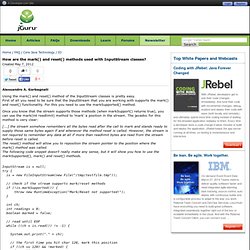

Java. How are the mark() and reset() methods used with InputStream classes? Alessandro A.

Garbagnati Using the mark() and reset() method of the InputStream classes is pretty easy. First of all you need to be sure that the InputStream that you are working with supports the mark() and reset() functionality. For this you need to use the markSupported() method. Once you know that the stream supports those methods (when markSupport() returns true), you can use the mark(int readlimit) method to 'mark' a position in the stream. . [...] the stream somehow remembers all the bytes read after the call to mark and stands ready to supply those same bytes again if and whenever the method reset is called. The reset() method will allow you to reposition the stream pointer to the position where the mark() method was called. The following code snippet doesn't really make any sense, but it will show you how to use the markSupported(), mark() and reset() methods. To make it running you should create a file containing all the char from 0 to 255. The basics of Java class loaders.
The class loader concept, one of the cornerstones of the Java virtual machine, describes the behavior of converting a named class into the bits responsible for implementing that class.

Because class loaders exist, the Java run time does not need to know anything about files and file systems when running Java programs. What class loaders do Classes are introduced into the Java environment when they are referenced by name in a class that is already running. There is a bit of magic that goes on to get the first class running (which is why you have to declare the main() method as static, taking a string array as an argument), but once that class is running, future attempts at loading classes are done by the class loader.
At its simplest, a class loader creates a flat name space of class bodies that are referenced by a string name. Class r = loadClass(String className, boolean resolveIt); All Java virtual machines include one class loader that is embedded in the virtual machine. "So what? " . . Programming tutorials and source code examples. ByteArrayInputStream (Java Platform SE 6) Apatite. 4/10/2010 -- New implementation added for the core Eclipse APIs. 2/11/2010 -- New association types have been added: sub-packages and packages that are commonly used together. 12/1/2009 -- Actions now have more verbs!

The index has been updated to include verbs that have been extracted from Javadoc method descriptions. 11/30/2009 -- The research behind Apatite’s development earned an Honorable Mention in the Computing Research Association’s 2010 Outstanding Undergraduate Research Award competition. 5/6/2009 -- Apatite won first place in the “Yahoo! Apatite, which stands for Associative Perusal of APIs That Identifies Targets Easily, is a tool for learning and exploring the Java 6 API.
Apatite is being developed as part of the Natural Programming Project in the Human-Computer Interaction Institute at Carnegie Mellon University. (If you like Apatite, please check out our other documentation tool, called Jadeite!) Hovering over the ? Now, click here to try it! Daniel S. Abstract: Download: (pdf) Generics in J2SE 5.0. By Budi Kurniawan 07/06/2005 Generics are the most important feature in J2SE 5.0.

They enable you to write a type (a class or an interface) and create an instance of it by passing a reference type or reference types. The instance will then be restricted to only working with the type(s). For instance, the java.util.List interface in Java 5 has been made generic. When creating a List object, you pass a Java type to it and produce a List instance that can only work with objects of that type. The first benefit of generics is stricter type checking at compile time. This article teaches you to use and write generic types. Life Without Generics All Java classes derive from java.lang.Object, which means that all Java objects can be cast to Object.
Java. Apprenez à programmer en Java.